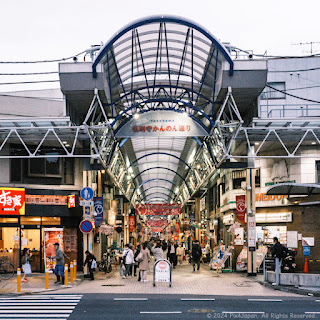Download a licensed digital photo: pix4japan.picfair.com
Order a print: pix4japan.smugmug.com
Nostalgic Delights: Yoroi-bari Cladding and Gacha-Gacha Machines in Japan
Location: Gumyoji, Minami Ward, Yokohama, Japan
Timestamp: 17:30・2024/04/09
Fujifilm X100V with 5% diffusion filter
ISO 1250 for 1/250 sec. at ƒ/2.0
Classic Negative film simulation
Two blocks west of the east entrance of the Gumyoji Shotengai shopping arcade lies a charcoal-grilled yakiniku shop. Its interior and exterior are meticulously designed to evoke a retro ambiance reminiscent of a Japanese house from the 1950s.
This quaint restaurant has garnered numerous positive reviews for its charming interior, menu offerings, and attentive service. Yet, it's not the restaurant itself that captivated my attention. What truly intrigued me was the striking contrast between the dark, classic traditional wooden “yoroi-bari” cladding and the shiny, late Showa era, gacha-gacha toy capsule machines.
Old wooden houses adorned with yoroi-bari cladding can still be spotted today, both in urban and rural areas. Many of these structures date back to the Showa period (1926–1989), while some have been meticulously restored from the earlier Meiji period (1868–1912) and are showcased in open-air museums.
Yoroi-bari cladding is characterized by grooves cut into the upper and lower portions of each plank, allowing them to interlock with the joints of adjacent planks. This ingenious design not only fortifies the walls against winds, rain, and temperature fluctuations but also provides flexibility during small to moderate earthquakes, allowing the structure to better withstand seismic stresses.
While gacha-gacha toy capsule machines were initially marketed towards children, they have evolved to be cherished by individuals of all ages, including adults, for nostalgic reasons. These machines have gained popularity even among adult tourists from abroad, many of whom were likely introduced to the machines through Japanese anime and manga.
Glossary:
- 鎧張り・yoroi-bari: A type of traditional cladding, often wooden, found on the exteriors of Japanese houses or other small structures. The term “yoroi” originates from the traditional Japanese armor worn by samurai warriors, consisting of numerous small metal plates laced together with silk or leather cords to provide flexibility and strength. Similarly, yoroi-bari cladding achieves these advantages by overlapping panels using interlocking joints.
- ガチャガチャ・gacha-gacha: The term “gacha-gacha” is an onomatopoeic representation of the sound produced by the toy vending machine during the action of hand-cranking the handle to retrieve a toy encased in a plastic capsule.
References:
Copyright Notice for All Images:
© 2011-2024 Pix4Japan. All rights reserved.
Unauthorized use for AI training is strictly prohibited.
Visit www.pix4japan.com for prints and licensed download options.





